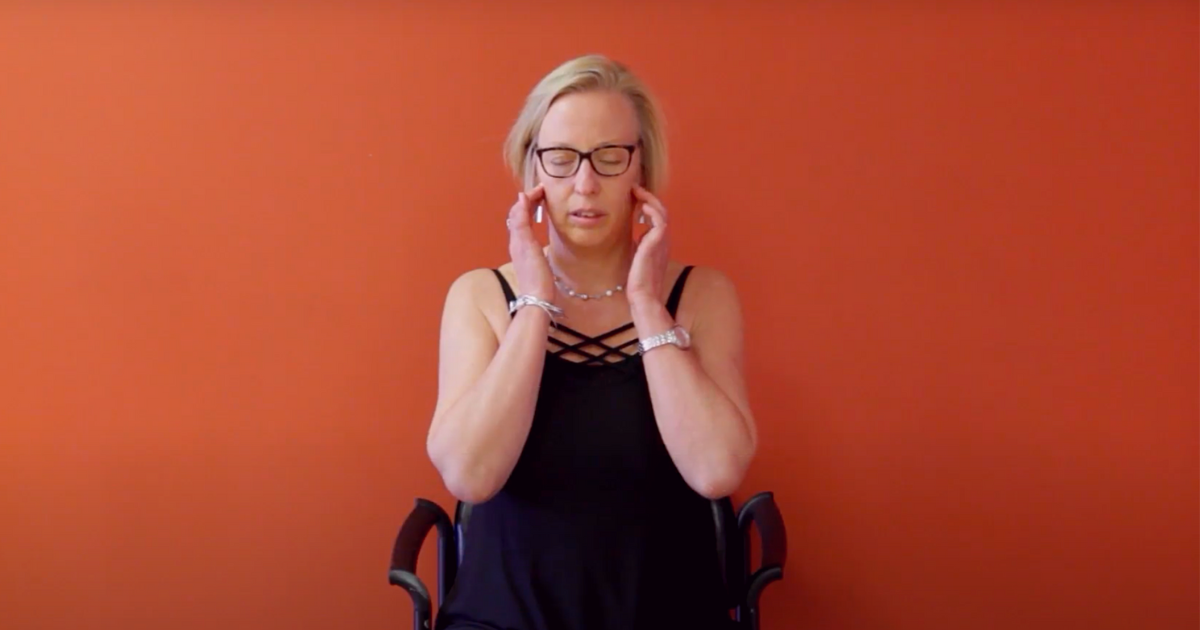Body Mapping - Decreasing the Sensitivity of the Nervous System
By: Carolyn Vandyken, BHSc (PT) ∙ Estimated reading time: 7 minutes
By: Carolyn Vandyken, BHSc (PT) ∙ Estimated reading time: 7 minutes
Everything that we do is mapped in our brains
Every time we learn a new activity, our brain maps that experience for future reference.
For example: think about a simple activity like buttoning a shirt. Imagine if every time you wanted to button your shirt you had to think about how to hold the button, how to manipulate the buttonhole, and how to slide the button through.

Recall the last time you buttoned a shirt. Now imagine you have a deep cut on your thumb. It hurts every time you try to button up.
You have three choices:
- Stop wearing button-up shirts for a while,
- "Re-map" how to button your shirt, or
- Keep buttoning your shirt the same old way even though it hurts.
If you find a non-painful way to button your shirt, this new map may become your new normal, especially if you change your buttoning map for more than several weeks.
The second option is to wear sweaters, avoiding shirts altogether.
With both of these logical responses, you may avoid the problem of having a pain neurotag* attached to your "buttoning" map as your thumb heals.
*Think of a neurotag as a bundle of neurons that go off like fireworks in the brain to make something happen, like pain.
Now consider Option 3: Continuing to button the shirt the old way even though it produces pain. This choice may lead to some long-term problems with wearing shirts. You may develop a new map of buttoning your shirt that keeps the pain neurotag attached to the activity even after the thumb has healed.

Traditional maps and brain maps
Maps in the traditional sense help guide you to your destination.
If you spill a cup of coffee on a map in the car, leaving the map unreadable, your stress levels will likely increase. You now have several options: buy a new map, stop and ask for directions, or follow your best guess based on the information you have.

Your brain may protect you and only allow minimal movement in the area. Your brain may get stuck in stress mode and pump out stress hormones which may increase your pain. When an old map is no longer helpful the best solution is to ask for help and get a new map.
As physiotherapists and healthcare practitioners, we can use remapping exercises to create a brand-new map of the painful area.
Mapping exercises give your brain a fresh movement experience so that your brain can go back to creating all types of pleasurable movements and sensations from that body part, not just pain.
As long as your brain is only playing the "pain tune", much of the information coming and going from your brain in regard to your sore body part will continue to require guarding and protection (pain and stiffness).
Remapping helps your brain to learn a new tune.
“Remapping” an area of your body is one strategy to allow you to get where you want to with less stress and pain.
Here's a short example of a body mapping exercise by Carolyn Vandyken:
Follow along with the video below or read the instructions that follow!
Step 1: Consumer comparison
We're going to start this exercise by releasing tension in your jaw and at the base of your skull. Start in a comfortable position on a chair.
Begin by doing a consumer comparison. Close your eyes, if that's comfortable. Notice your posture. Notice the tension or relaxation of your jaw muscles and your forehead. Notice the tension or relaxation of your shoulders and at the base of your skull. Just notice.
Step 2: Open and close the jaw joint
Now take two fingers and place them in front of your ears, on the joints of your jaw. Slide them gently forward until you are in the small, soft depression in the front of the joint. Open and close your mouth a couple of times to make sure that you can feel the jaw joint moving. Notice if both joints move equally. Don't worry if they don't; this can be quite normal. Continue to feel the joint as you open and close your jaw.
See if by just noticing that they aren't quite equal, you can create a better balance on both sides, just by becoming aware of it. Soften your jaw as you move and imagine balanced movement in both jaws for about 30 more seconds.
Step 3: Unhinging the jaw joint
The next exercise is called unhinging the jaw joint. Take all four fingers from the jaw joint and rake down your face until you get to the bottom of your jawbone. Think of the screen painting.
Relax your jaw as you are raking your fingers down towards the jawbone. Say "ah" as you are raking your jaw. Continue for 30 more seconds.
Now grab two soft semi-deflated mini basketballs, and place them at the jaw joint. Open and close your jaw joint, but this time, slightly rotate them forward as you open the jaw and backward as you close the jaw.
Make a sound again as you open your jaw, rotating the balls forward. The sound "ah" works really well when you do this.
You can also do this with your knuckles if you don't have these balls. Rotate your knuckles forward as you open your jaw, and backwards as you close your jaw. You can also move up and down the muscles in your lower cheeks as you do this. Continue to rotate the balls or your knuckle forward as you open your jaw, and rotate the balls or knuckle backward as you close your jaw. Continue for 30 more seconds.
Step 4: Reduce tension in the shoulders
Now we are going to be working on reducing the tension in your shoulders. Take one ball and place it under the armpit of one shoulder. Get as high into the armpit as you can comfortably. Rest your hand wherever it is comfortable.
Take several slow, relaxed breaths. Breathe into the ball as you breathe in, and breathe out, growing a little taller each time through the tops of the ears. Don't overstretch. Soften as you grow taller.
Now shrug your shoulder as you breathe in and relax your shoulder down as you breathe out. Imagine that as you breathe in, the muscles between your shoulder and neck, known as your trapezius muscle, are like a giant sponge, and you squeeze water out of the sponge as you breathe in, and allow the sponge to fill up again with water as you breathe out, relaxing and lowering your shoulder. Repeat this another couple of times.
Then start rolling your shoulder forward. Make big relaxed circles. Think about the face of a clock and touch every number on the clock as you roll forward, and then change directions and roll backwards three or four times, again noticing all the numbers on the clock.
Take the ball out from underneath your armpit and just take a moment to notice the difference between the side you worked on and the side that you have yet to work on.
Place the ball back under the opposite armpit this time. Again, taking slow, relaxed breaths. Breathe in, shrugging your shoulder up towards your ear. Breathe out, relaxing the shoulder down towards the ground. Breathe in, imagine you're squeezing the sponge out. Breathe out, and allow water to fill in the sponge. Remember the sponge is the big muscle at the top of your shoulder called the trapezius. That's where you're working on tension, and letting that tension go. Go at your own pace.
Now start to make circles in a forward direction, thinking about all the numbers on the clock and touching all of the numbers in a smooth, relaxed way. Three or four circles forward, and then three or four circles backward.
Now take the ball out again and just take a moment to notice your shoulders and your trapezius. Do they feel different?
Step 5: Release tension at the base of the skull
The last exercise is to release tension at the base of your skull. Take your right hand and find the soft divot or hollow at the base of your skull. It's called your suboccipital muscles.
Massage them gently, creating space in that hollow, imagining that that hollow is yawning and softening.
Take your other hand just below your jaw joint and at the base of your throat, find where your tongue is attached. With your other hand, gently move your tongue back and forth as you continue to do circular massages at the base of your skull. This relaxes the tension in these muscles.
Before switching sides, just notice, is there a difference in the jaw and the base of the skull on the side you worked on compared to the side you haven't worked on yet? Just notice.
Now switch sides. Take your other hand, find the muscles at the base of your skull in the soft hollow and massage them. Circular motions, softening and relaxing that area.
Take your other hand under the jaw joint under the base of the jaw and find your tongue and gently move your tongue back and forth as you continue to make small circles at the base of your skull.
Now rest your hands back in your lap and just notice the difference in the base of the skull and in your jaw.
Step 6: Consumer comparison
Let's do a consumer comparison compared to when we first started these exercises. Are there any changes in your shoulders, jaw, and the base of your skull? Are there any changes in your mind or your thoughts? Do you feel calmer? Any less stressed? This is a great exercise to prepare yourself for meditation.
Namaste.
---
Date published: 24 March 2021
Last update: 30 Oct 2024

BHSc (PT)
Carolyn is the co-owner of Reframe Rehab, a teaching company engaged in breaking down the barriers internationally between pelvic health, orthopaedics and pain science. Carolyn has practiced in orthopaedics and pelvic health for the past 37 years. She is a McKenzie Credentialled physiotherapist (1999), certified in acupuncture (2002), and obtained a certificate in Cognitive Behavioural Therapy (CBT) in 2017.
Carolyn received the YWCA Women of Distinction award (2004) and the distinguished Education Award from the OPA (2015). Carolyn was recently awarded the Medal of Distinction from the Canadian Physiotherapy Association in 2021 for her work in pelvic health and pain science.
Carolyn has been heavily involved in post-graduate pelvic health education, research in lumbopelvic pain, speaking at numerous international conferences and writing books and chapters for the past twenty years in pelvic health, orthopaedics and pain science.
